
by Larry Williams | Jan 27, 2020
Q. I have a camellia plant that is about 25 years old. It forms flower buds but the buds never fully open. The plant otherwise looks healthy. Is there something that I’m doing or not doing that causes this?
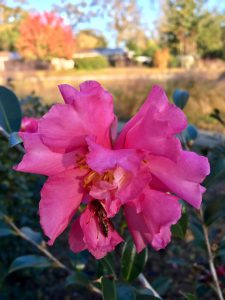
Sasanqua camellia bloom, Photo credit: Larry Williams
A. I have seen this happen over the years. There are a number of possibilities for why this happens. If the camellia cultivar is otherwise known to do well in the area, the problem could be caused by one or more of these factors.
- Stress (primarily drought stress could inhibit buds from opening)
- Freeze damage
- Too many buds on the plant to allow each and every bud to open
However, with this being the norm for your camellia plant for that many years, it may be the wrong camellia variety in the wrong place.
Camellias have been so common in our Southern landscapes that some people think they are native to our area. However, camellias are native to Asia. They were first brought to America during the latter part of the 1700’s.
Years ago, people planted any camellia they could get their hands on because camellias weren’t as common or available and definitely had a more limited selection.
Some camellia cultivars are simply not well adapted to the Gulf Coast and, as a result, will not flower well even though they may grow well here. This is why some varieties are favored in Seattle, some do better in California, some do better in New England and others perform well here in the South.
Even though camellias are a common sight in shady Southern gardens now, not all camellias will perform well here. So, it is important to do some homework before purchasing and planting just any old camellia.
As stated in the UF/IFAS Extension publication Camellias at a Glance, “There are numerous species of Camellia, but the types commonly grown as landscape shrubs in Florida are Camellia japonica, Camellia sasanqua, and hybrids of these.” This publication is available online at https://edis.ifas.ufl.edu/pdffiles/EP/EP00200.pdf or from the UF/IFAS Extension Office in your County.
Sasanqua and japonica camellias come in whites, pinks, reds, double and single flowers and sizes from four to twenty feet tall.
The sasanqua types bloom as early as October while the japonica types begin flowering later.
It is possible to select a few different varieties, instead of just one, to extend the color in your landscape from weeks to months. Selecting camellias for staggered flowering times can provide color all fall and winter long.
When purchasing camellias, research the bloom times of varieties for your area.
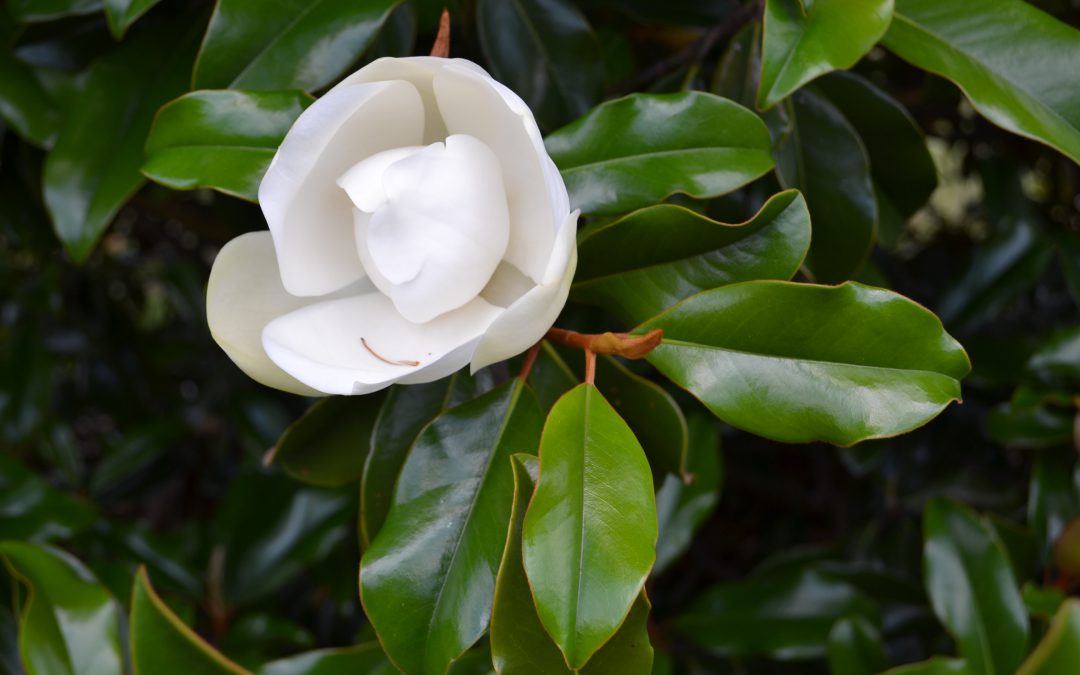
by Beth Bolles | Jan 13, 2020
The Southern magnolia (Magnolia grandiflora) has always been a favorite tree since it is associated with my childhood home in Tennessee. I always enjoyed the evergreen leaves and large white flowers. In my parent’s yard, the southern magnolia had branches to the ground that allowed the large leaves to stay hidden in a self- mulching area. I never recall the tree begin called messy because of this growth style.
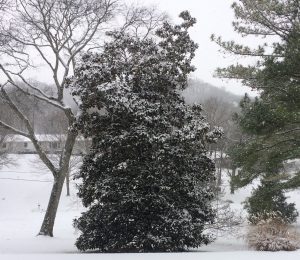
A Southern Magnolia in a Tennessee winter. Photo by Beth Bolles, UF IFAS Extension Escambia County
Many landscapes today may not have room for a southern magnolia that can grow an average of 60 feet in height with an average spread of 25 feet. Because it’ qualities are still desirable, nursery professionals have developed southern magnolia cultivars that are very popular as landscape features due to different growth habits, leaf sizes, and hardiness to our area’s weather. Although the cultivars will be different from the old favorite southern magnolia in growth form and size, homeowners should still do their homework to make sure trees are located in spots for plants to reach proper height and width growth. Also, like I mentioned for my parent’s tree, many of the new cultivars look best if the lower limbs are not removed.
If you or your landscaper are considering a Southern magnolia cultivar, here are a few details about some you may find available.
‘Little Gem’ dwarf southern magnolia has been the go-to magnolia for new landscapes. The dark green leaves are smaller and the plant will be more compact than the traditional southern magnolia. It is often misplaced in landscapes because of these features. Trees still grow about 25 feet high with a spread of 15 feet.
‘Bracken’s Brown Beauty’ is a very attractive magnolia when given room to grow. Foliage is very attractive with shiny green above and brown on the undersides. This plant can grow 40 to 50 feet in height with a spread averaging 20 feet. Plan not to prune lower limbs to maintain a beautiful form.
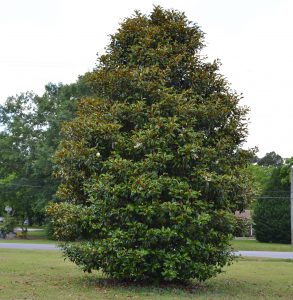
Bracken’s Brown Beauty as an accent tree in a lawn area. Photo by Beth Bolles, UF IFAS Extension Escambia County
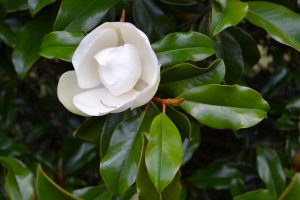
Bracken’s Brown Beauty flower. Photo by Beth Bolles, UF IFAS Extension Escambia County
‘Southern Charm’ magnolia, registered as Teddy Bear is also a compact plant. It grows upright to about 20 feet with a spread about 15. You still have the beautiful green and brown leaf color along with 6 inch wide flowers.
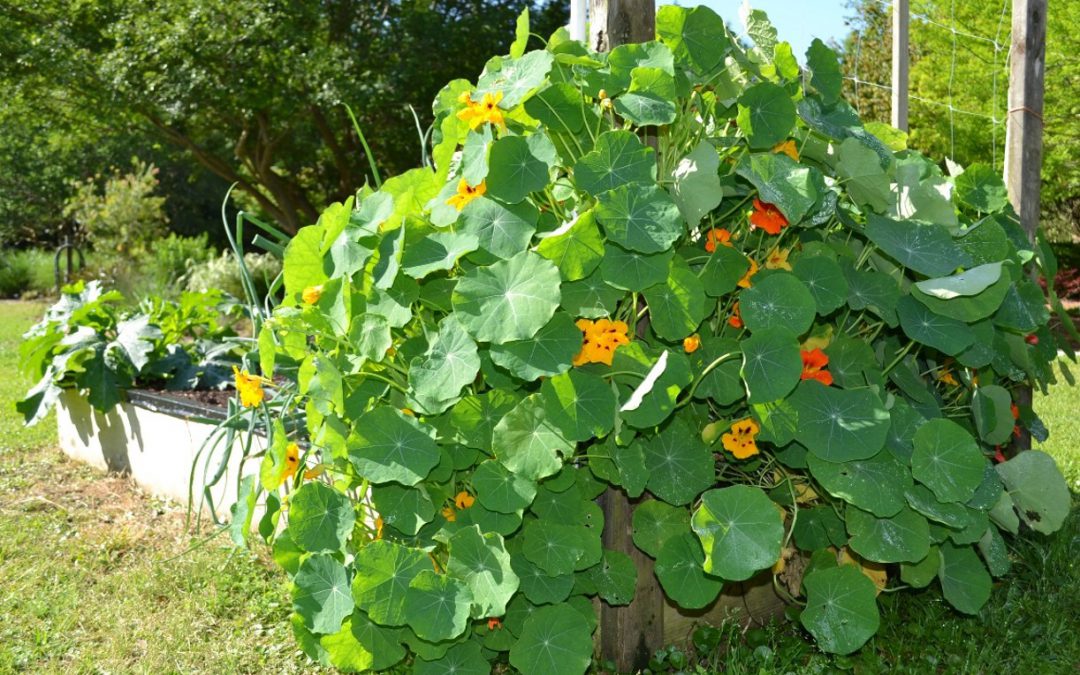
by Beth Bolles | Aug 28, 2019
More and more homeowners are incorporating edible plants into their home landscape in order to enjoy the fresh taste of fruits and vegetables. Another trend to consider this coming cool season is to start a few common flowers that can serve as flavor enhancements for many of your dishes.
There are numerous plants that we commonly grow that have edible flowers but before striking out on your first taste test, be sure to research first. Always remember the common saying that every flower is edible once. Find a reputable reference guide from a friendly neighborhood Extension office for a list of common edible flowers, then be ready to start from seeds. It is best not to purchase transplants from an ornamental nursery unless you are sure of all the treatments for that plants. Nurseries are often selling these for beauty alone, not with intention that they will be eaten.
Here are a few edible flowers to try:
Pot marigold or Calendula is a wonderful cool season flower on its own. Brightly colored orange or yellow flowers improve the drab colors of our cool season and plants are sturdy annuals for borders, mass plantings, or in containers. Petals have a peppery flavor and add spice to salads and sandwiches. You may also add flowers to soups, fishes and butters for added coloring. Calendula petals can be a saffron substitute.
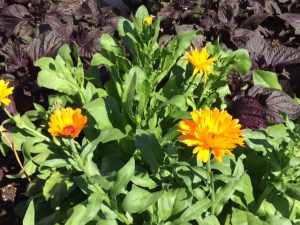
Calenduala is easily started from seeds and will reseed in your garden once established. Photo by Beth Bolles, UF IFAS Extension Escambia County.
The well known dianthus is a great transition plant as our days cool and warm up again the spring. Use as front of the border plantings or in containers as a filler. When harvesting petals of dianthus, you will want to remove the white petal base which is a little bitter. The flavor is a little more delicate than cloves so you can add petals to punches, desserts, and fruit salads.
If you like a little more spice, try nasturtiums. We often plant these after the last frost and they grow until we get too hot. Since our fall weather is so unpredictable, you may be able to start some seeds for a fall planting and have flowers before our first cold spell. Either way, nasturtium flowers are often sliced for salads and sandwiches as a mustard or pepper substitute. You can also mince flowers to add to a butter. If you let some flowers go to seed, collect the unripe seeds to make a caper substitute vinegar.
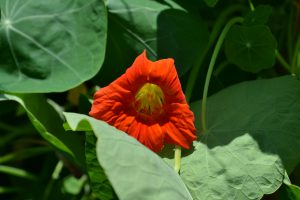
Grow nasturiums during our transition times of spring and fall. Photo by Beth Bolles, UF IFAS Extension Escambia County.
If you are going to use edible flowers from your garden remember to keep all non food labeled pesticides away from plants. Harvest flowers at their peak after the dew dries. Separate petals from other flower parts and if you have allergies be sure to remove any pollen. Place flowers in a moist towel in the refrigerator if you will not use them immediately. Rinse carefully so not to damage tender petals.
There are many other ornamental plants that offer edible flowers you may want to consider growing in the future. These flowers not only enhance the look of the dish but can offer unique flavoring from a locally grown source – your own backyard.
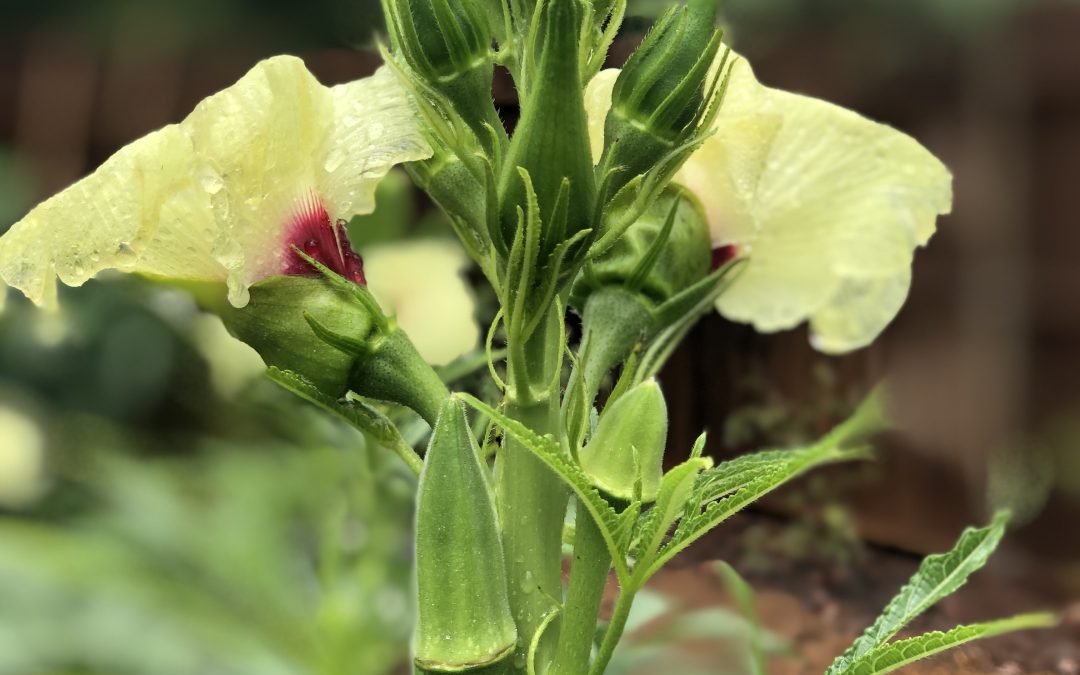
by Daniel J. Leonard | Aug 20, 2019
Though Okra (Abelmoschus esculentus) fruit isn’t much more than a thick green hull, slime and seeds and the plant itself is impossibly irritating to the skin, few plants are as integral to Southern heritage. In my mind, okra is among the best vegetables Panhandle gardeners can grow. Not only is it a gorgeous plant – Okra belongs to the Mallow family which also includes beauties like Hibiscus and Cotton – but it’s exceedingly versatile in the kitchen, excellent fried, grilled, roasted, boiled (though you have to acquire a taste for slimy textures to enjoy this method) and most famously, as a thickening agent in Cajun gumbo. Because of this exalted status in Southern culture, whether you enjoy eating okra or not, it’s almost mandatory here to include the plant in one’s garden. Most gardeners stick with the old standard varieties such as ‘Clemson Spineless’ or ‘Cowhorn’ and there is nothing wrong with them, however, these plants are almost too prolific for most gardens (growing upwards of 6-7’), especially for those of us growing in the close confines of raised beds. In the search for a less rambunctious but still ultra-productive cultivar, this summer I trialed ‘Jambalaya’, an F1 hybrid developed by Sakata Seed in 2012, with impressive results!
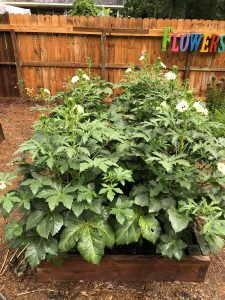
‘Jambalaya’ Okra in the author’s garden.
From my experience growing the cultivar this summer, ‘Jambalaya’ merits consideration in the garden, and is a must for raised bed gardeners, for two primary reasons. First, it was bred to be compact and is considered a dwarf cultivar. This is an awesome attribute, as I typically end the growing season picking okra from a small ladder! Most seed purveyors tout the plant as reaching a maximum height of 3-4’ and while this estimate might be a little conservative, I can attest that ‘Jambalaya’ is greatly reduced in height compared to the standard cultivars. The second advantage of growing this variety is that it begins producing very early relative to its peers and bears heavily. ‘Jambalaya’ fruit begin to ripen in about 50 days, about ten days to two weeks earlier than ‘Clemson Spineless’, a definite advantage if rotating behind a late maturing spring crop like potatoes as I typically do. Though ‘Jambalaya’ is a dwarf plant, in no way are yields reduced. My specimens have produced continuously since late-July and will continue to do so as long as adequate fertility and consistent harvesting are provided.

‘Jambalaya’ flower & fruit production.
Like any other okra cultivar, ‘Jambalaya’ has a couple of basic requirements that must be met for plants to thrive. In general, all okra cultivars love Southern summers and patience sowing seed is recommended, allow the soil to warm to at least 70 degrees before planting. Okra also prefers full sun, at least 6 hours per day, any less and yields will be reduced and plants will stretch towards the light. Belonging to the Mallow family, okra requires consistent moisture, particularly when in the flowering and fruiting phase. Finally, it is critical to keep up with your okra harvest as the plants produce! Okra pods grow quickly and should be harvested when they are no more than 3-4” long and still tender, larger pods are tough to the point of being inedible!
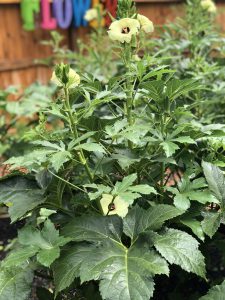
‘Jambalaya’ in the author’s garden.
Whether you’re new to the okra growing game or you’re a seasoned gumbo gardener, I highly encourage you to give ‘Jambalaya’ Okra a look next summer. While ‘Jambalaya’ is available through many seed sources, Johnny’s Selected Seeds sells a conveniently small package perfect for backyard gardeners, though they’ll be happy to provide larger quantities as well. In ‘Jambalaya’ you’ll find a nice compact plant that won’t outgrow your space, provide you a summer long harvest of tender green pods, and will rival the ornamentals in your landscape for the title of prettiest plant on your property! Happy gardening and as always, if you have questions about vegetable gardening or any other horticultural or agronomic topic, please contact your local UF/IFAS County Extension office!
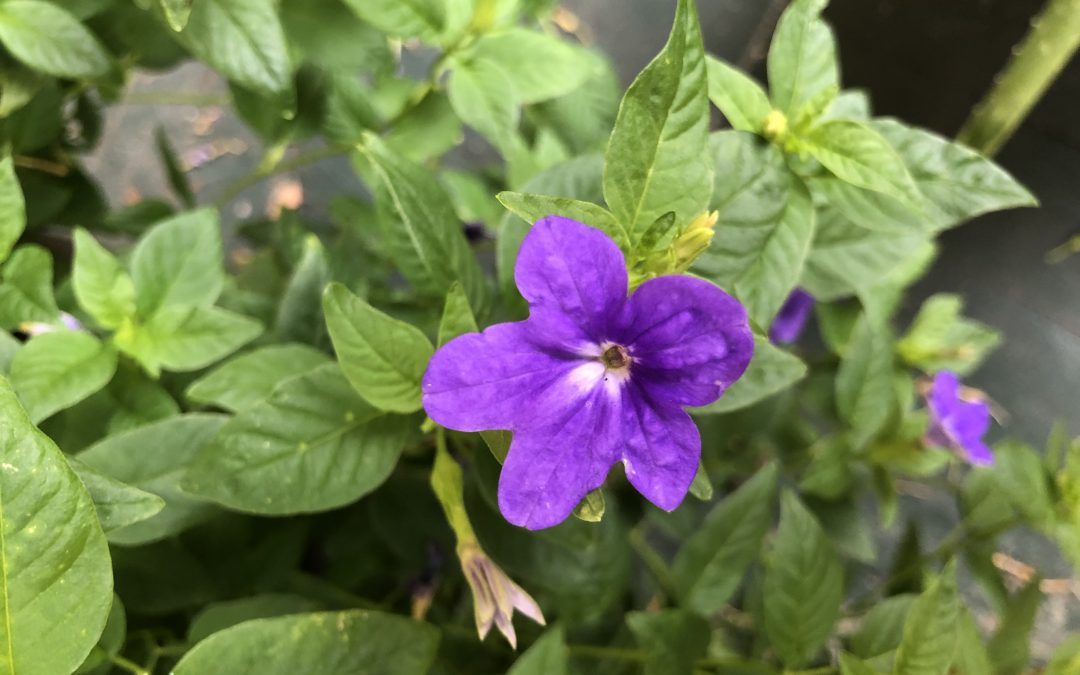
by Daniel J. Leonard | Aug 12, 2019
As an unabashed plant enthusiast who’s been experimenting with new plant introductions (some not really “new”, just new to me) in his own landscape, and his parent’s yard before that (sorry guys for the ‘Charmed Wine’ Oxalis that now pops up unwanted every spring) for nearly two decades now, at this point I’m pretty hard to impress. However, last year Andrea Schnapp, a UF/IFAS Walton County Master Gardener, introduced me to a newish plant that has since changed the way I choose plants to color shady pots and planting beds, a little native of tropical South America called Bush Violet (Browallia spp.), specifically the hybrid ‘Endless Illumination’.
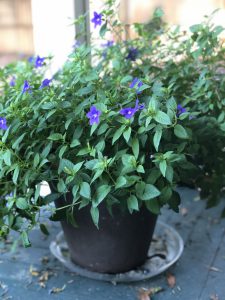
Browallia ‘Endless Illumination’ on the author’s back porch.
For decades, the standard bedding plant for color in the shade in the Deep South has been Impatiens walleriana. However, in the last few years, a new disease called Impatiens Downy Mildew has wreaked habit on the bedding plant species, virtually eliminating it as a serious player in the horticulture industry. Fortunately, the fine folks at Proven Winners introduced ‘Endless Illumination’ a couple of years ago to fill the niche formerly occupied by old-fashioned Impatiens. And boy, is ‘Endless Illumination’ aptly named. The unending masses of star shaped flowers are an absolutely brilliant purple hue that does indeed light up shady areas in the landscape. I’ve encountered few plants put forth such a proliferous display of flowers for as long of a time as this Browallia selection has, and it doesn’t even require deadheading!
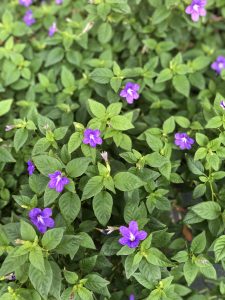
Browallia ‘Endless Illumination’ flowers.
In addition to having one of the more striking color displays of any bedding plant, Browallia happens to be a vigorous grower with an extremely hardy constitution. I’ve found ‘Endless Illumination’s mature size as listed on the sales tag as being a little conservative, instead of the 16” tall x 14” wide stated, my samples have consistently grown more than the 16” listed in height and doubled the width, no complaints here as this just means more flowers! And though my experience with Browallia has strictly been in containers so far, it has weathered heat and bounced back from drought like a champ. It’s not super important to know that the container it occupies is sited under my back porch roof and therefore is subjected to human induced drought by my forgetting to water it, good performance in droughty conditions is good performance in droughty conditions! Finally, Browallia requires the bare minimum of fertilizer to thrive. A good topdressing of a slow-release fertilizer (rates according to the product’s label, of course) at planting and an identical refresher dose mid-summer have induced great performance and no noticeable nutrient deficiencies.
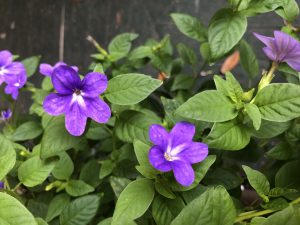
Browallia ‘Endless Illumination’ flowers
A quick note before we adjourn, when perusing nurseries next spring for Browallia, you’ll likely encounter the sister cultivar of ‘Endless Illumination’ with white flowers, named ‘Endless Flirtation’. I’d encourage you to stick with the purple flowers of ‘Endless Illumination’ as I’ve found, through personal growing experience and anecdotes from other growers, ‘Endless Flirtation’ to be noticeably fussier than and not nearly as attractive as its sister plant.
Sometimes, the misfortunes of one plant are a merely an opportunity for another plant to claim its place in the flower bed. Browallia ‘Endless Illumination’ has taken the spot occupied by Impatiens walleriana and quickly become a garden favorite. Look for this awesome little annual in garden centers next spring! And remember, if you have any questions about this newly introduced plant or any other horticultural topic, please contact your local UF/IFAS Extension office! Happy gardening!

















